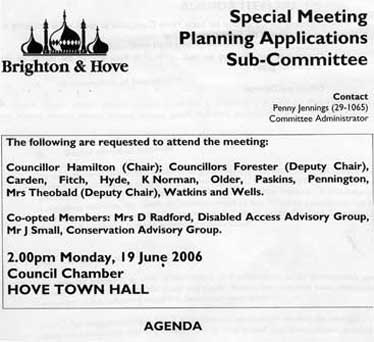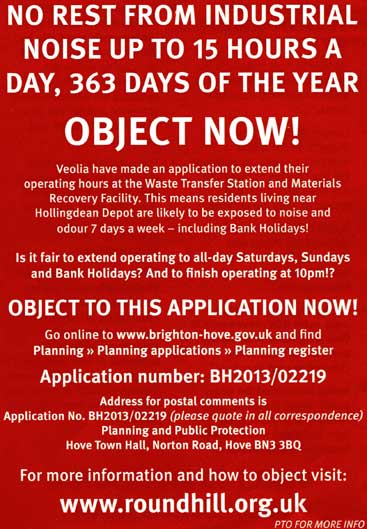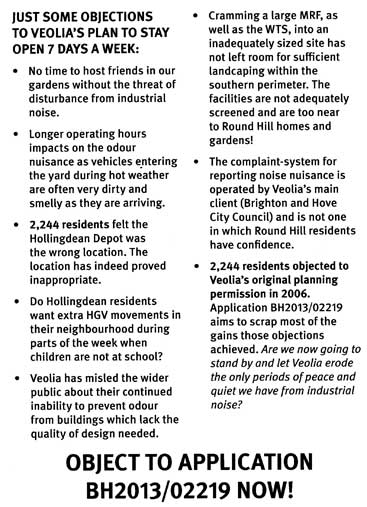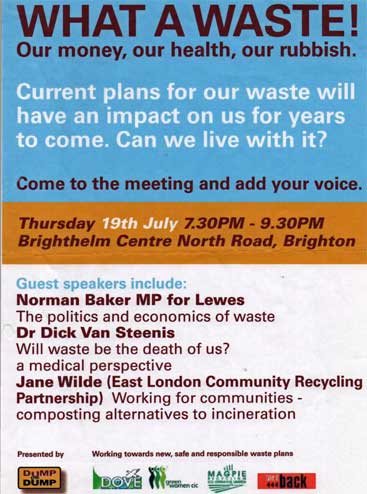Hollingdean Depot
Index
Articles - unsuitability of Hollingdean Depot; what to put in its place
Chronology - the history of Hollingdean Depot from 2003 to 2025
Articles (undated)
Unsuitability of Hollingdean Depot especially The Waste Transfer Station
Food Waste Collections current discussion on the need to bypass the Hollingdean Waste Transfer Station.
Life near the Dump (where to complain RE odour / noise / dust etc.)
The Environment Agency's operating licence - please report incidents of these terms being breached to The Environment Agency on their hotline 0800 80 70 60.
Life fighting a proposed dump (other examples)
- the Pinkham Way Alliance (London), and
- the Portobello (Edinburgh) campaign PONGS to avoid siting a Waste Transfer Station next to a conservation area.
Deficient design of Hollingdean's Waste Transfer Station, in particular the absence of an airlock entry system (i.e. a sealed vestibule with two sets of doors - now standard practice) makes it unsuitable for containing odorous waste. This omission and the implication that food waste needs to be separately collected and taken elsewhere is contained in the letter from The Environment Agency to residents who have complained about odour escapes.
Airlocks are standard best practice in modern waste management facilities, not only for odour but also for dust, vermin, and bioaerosol control (i.e. minimizing the presence and impact of airborne biological particles, such as bacteria, fungi, and viruses, in the air).
Why have there been so many fires at Hollingdean's Waste Transfer Station?
What to put in its place
Planning for 2033 when Veolia's PFI deal with Brighton & Hove City Council will end.
1. Arguments for moving the Waste Transfer Station and Materials Recovery Facility from Hollingdean Depot?
2. Planning brief for sympathetic residential housing (circa 300-home scheme) with provision for greenspace on the site of Hollingdean Depot to replace The Waste Transfer Station, the Materials Recovery Facility, Dudeney Lodge and Nettleton Court, including the cost of decontamination of both WTS and MRF sites.
Chronology 2003-2025
April 2003 - 25-year Integrated Management Services Contract with Brighton & Hove City Council (BHCC) and East Sussex County Council (ESCC). The contract was extended by 5 years in 2007. Before winning the contract, Onyx declared its intention to build an anaerobic digestion plant at Pebsham, Bexhill. After the contract was awarded, the anaerobic digestion plant was conveniently forgotten.
May 2003 to October 2003 - Inspector to public inquiry on objections to BHCC's / ESCC's Waste Local Plan recommended that Hangleton Bottom and well as Hollingdean Depot should be retained for Materials Recovery and Waste Management Facilities. Note that Hangleton Bottom was identified in the Brighton & Hove Local Plan (adopted in July 2005) as a site for a Materials Recovery Facility (MRF) which was never built there.
23rd June 2005 Public Meeting: Brighton & Hove City Council and Veolia. Full transcript. One of the purposes of this meeting, held at the Downs Infants School, was to allow experts representing Onyx (now Veolia) to speak about the anticipated impacts of their scheme for a Waste Transfer Station and Materials Recovery Facility at Hollingdean Depot Brighton. Referring to the proposed Waste Transfer Station, Roger Barrowcliffe from ERM assured us that
18th July 2005 Public Meeting: Brighton & Hove City Council and Veolia at the Sallis Benney Hall. Full transcript. This meeting was called since the last venue (The Downs Infant School on 23rd June 2005) was too small to accommodate all the residents who wanted to attend. When asked about the problem of smell, John Collis from Veolia said:
Nobody had the technical knowledge or foresight to ask if the Waste Transfer Station would be fitted with an airlock entry system (i.e. a sealed vestibule with two sets of doors) to maintain negative air pressure within in order to minimise odour escapes through the doors. Consequently, there was never any planning condition to ensure standard best practice in the design of the Waste Transfer Station. Neither did anybody ask about the scenario of industrial action and odorous waste being stored for far too long, as happened in 2013.
2nd February 2006 Full transcript of Dump The Dump Campaign Meeting in relation to Veolia's BH2006/00900 application.
See also illustrated report as well as critique of BH2006/00900.
23rd March 2006 - Dump The Dump campaign press release.
8th June 2006 - Dump The Dump campaign meeting: final response.
17th June 2006 - Protest march against the siting of the Waste Transfer Station at Hollingdean Depot [Video: 4 min 15 sec]
19th June 2006 - approval of BH2006/00900: Construction and operation of a Materials Recovery Facility, Waste Transfer Station and Visitor Centre/Office building and ancillary infrastructure including gatehouse building and weighbridge, parking and highway revisions including creation of new access off Upper Hollingdean Road. | THE ABATTOIR, Hollingdean Lane, Brighton, BN1 7BB (Former Abattoir and Depot Site Hollingdean Lane Brighton).
19th June 2006 Report on the planning committee meeting.

19th June 2006 - Case officer's report on BH2006/00900 including the 53 original planning conditions, the development proposals, the Environmental Statement, the Consultations [residents' comments, local politicians' comments, Brighton Society and Conservation Advisory Group, Downs School Head's and Governors' comments, Internal consultees, Environmental Health, Planning Policy, Site selection process, Sustainability Team, Transport Planning and Policy, Impact on the amenity of occupiers of nearby residential properties, schools and businesses, Impact during construction, Design and appearance of the buildings and their impact on the immediate and wider townscape, including impact on conservation areas and listed buildings in the vicinity, and impact on distant views, Accessibility, Sustainability].
All the conditions (3, 4, 5 & 6) set to offer nearby residents respite from the operation of the WTS and MRF were dropped in 2013.
See 2013 changes. All the objections counted for nothing.
The Council's updated Planning Register shows Veolia's supporting documents for BH2006/00900, but no letters of comment are displayed under the documents tab.
Out of a total of 2182 letters of comment, there were 2157 letters from residents objecting to the scheme, 23 letters from organised groups objecting to the scheme and 2 letters from individuals supporting the scheme.
It is fair to mention that in 2006 most letters of comment were submitted on paper. Digitising them would be costly, though as a piece of planning history the Council's current online record is rather one-sided in the arguments presented.
June to October 2006 - reaction to approval of the scheme.
19th July 2006 Dump The Dump Meeting at the Brighthelm Centre on Alternative Strategies for Waste management
- Dr Dick Van Steenis - Will waste be the death of us? - A medical perspective - the risks of particulates, especially PM2.5s which are small enough to get into people's breathing tubes, as well as PM2s which can reach into the bottom of people's lungs
- The influence of Dr Dick Van Steenis on the incineration debate today
- Waste Hierarchy model: Ideal future waste system.
- Alternatives to the incineration of waste
- Jane Wilde - Community Composting - the very worst thing that we could do with food waste is to incinerate it together with other black bag waste. For example, the incineration of 3000 tons of food waste requires 870 tonnes of water - water which could be saved for far better uses.
October 2006 - construction begins.
7th December 2006 Dump the Dump campaign public meeting during demolition of existing buildings.
August 2013 - rushed planning application BH2013/02219 granted permission extending operating hours to 15 hours per day 363 days per year and doing away with conditions which gave residents respite from operation during weekends. The application was to accommodate the extension of communal bins, which need to be emptied regularly, but at the expense of the amenity of residents living near Hollingdean Depot. Communal refuse and recycling collections were introduced in most central parts of Brighton & Hove in 2013. The aim was to tackle problems with seagulls and foxes ripping open black bags and waste being blown around the streets.
| 1 | 2 | 3 | 4 | 5 | 6 | 7 | 8 | 9 | 10 | 11 | extension of hours


ADMISSION THAT THE DESIGN OF HOLLINGDEAN'S WASTE TRANSFER STATION IS UNSUITABLE FOR THE PURPOSE OF CONTAINING ODOROUS WASTE:
13th August 2014 - letter from the Environment Agency to residents who have made reports of odour from Hollingdean's Waste Transfer Station explaining that the design of the building, especially the failure to install an entrance airlock system makes it unsuitable for the purpose of containing odorous waste.
15th September 2014 - attempts to suppress odour by turning the deodorisers OFF overnight.
7 February 2017 - The Waste and Minerals Site Plan prepared by ESCC BHCC & The South Downs National Park Authority considered the option of using the Hollingdean Depot Waste Transfer Station for commercial & industrial waste as well as domestic waste.
2019 / 2020 / 2021 Fires at the Waste Transfer Station:
Safety concerns -
Notes from The Round Hill Society
1. Major fire on 25th August 2019 - fire crews take 12 hours to bring it under control.
- See: Demand for answers after Waste Depot fire
The Argus 6th September 2019. - The fire they're hoping everyone will forget
[The Argus 7th Sept 2020] - Dudeney Lodge and Nettleton Court
2. A second fire on September 2020.
3. A third fire on 29th September 2021
- See Fire at Brighton Waste Transfer site reignites neighbours safety concerns [Brighton & Hove News 5th Oct 2021], and
- Safety fears after fire at Veolia waste site in Hollingdean [The Argus 6th Oct 2021] for reports of a third fire.
2019 Deputation to BHCC Environment, Transport & Sustainability Committee
Following the fire at the Hollingdean Waste Transfer Station on 25th & 26th August 2019:
Read the deputation dated 26 November 2019
Read the responses to the deputation
Relevant minutes from the ETSC meeting of 26 November 2019
Failure to produce the promised report into suitability of The Waste Transfer Station [15th July 2025]
2025 Food waste may by-pass Hollingdean Depot site
Separate food waste collections: residents' concerns.
Update: 16 July 2025 from Cllr Tim Rowkin: "the plan was to transfer via the Hollingdean site. However, once the team got into the more detailed modelling, the view began to shift toward tipping directly at the composting facility. The plan as it stands is to start with that and keep under review as the rollout progresses. If that works, it will obviously be good news for residents in the area as the food waste will be removed entirely from the site. It is a trial though, so I don’t want to make any promises that this arrangement will remain in place."
The trial (missing out The Waste Transfer Station) is much welcomed, but delight at this news is tempered by two considerations:
What will happen if residents continue to mix food waste with black bag waste?
What is the likely rate of compliance in Brighton and Hove?
Answers to these questions suggest that food waste will not be removed entirely from the Hollingdean Waste Transfer Station, though acknowledgement that it is not meant to go there is progress.
Note that the absence of an airlock entry system at the Hollingdean Waste Transfer Station ignores best standard practice. Waste transfer stations typically rely on maintaining negative air pressure inside the building to keep odorous air from escaping. Without an airlock (a sealed vestibule with two sets of doors), each time a waste truck enters or exits, that pressure is disrupted, allowing foul air to escape directly into the surrounding environment.
Go to Non-hazardous and inert waste - appropriate measures for permitted facilities on the Environment Agency's website. See under EMISSIONS CONTROL - Enclosure within buildings Page 27 (sections 186 recommends installing an airlock entry system to minimise fugitive emissions) and page 29 (section 200 recommends the use of fast-acting or ‘airlock’ doors that default to closed).
4th February 2025 Additional Minutes from RHS Committee Meeting with Cllr Tim Rowkins to discuss residents' concerns about new Food Waste and expanded Recycling services. Tim is BHCC's Cabinet Member for Net Zero & Environmental Services.
10th October 2025 - Round Hill Society meeting with MP
Key issues relating to The Waste Transfer Station and residents' key asks - shared with Brighton Pavilion's MP Sian Berry.
